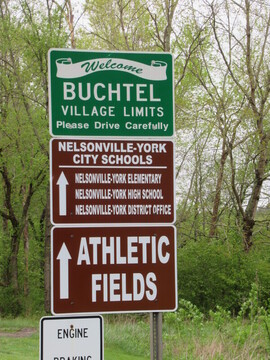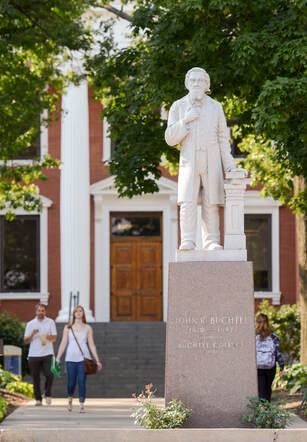 Modern Buchtel, Ohio Modern Buchtel, Ohio On my first trip to the Little Cities of Black Diamonds with my father years ago we went through the crossroads of Buchtel. It is an unusual name, so I asked him, "Is there any relationship between the name of this town and the Buchtel of the Akron University's founder and Buchtel High School?" "I think so," he answered. More recently I've found 'the rest of the story' so to speak. John R. Buchtel is responsible for both. Entrepreneur John R. Buchtel, born on January 18, 1820, in Stark County, Ohio is among the many individuals who became involved in early stories of Little Cities of Black Diamonds unionization in the late 1800s. A prosperous businessman, early on he engaged in farming, owning several farms, including one that was over one thousand acres in Ohio, and then expanding into Indiana. The timber on these holdings also involved him in the lumber industry. In 1863, Buchtel became an employee of Ball, Aultman, and Company, a farm machinery manufacturing firm in Canton, Ohio. He convinced the owners to build a second plant in Akron, Ohio. The new facility, the Buckeye Mower and Reaper Company, named Buchtel its first president. The company grew quickly, due in part to Akron’s canals and railroads which gave it easy access to raw materials and shipping. Expanding to the Little Cities During the 1870s, Buchtel also became the general manager of the Akron Iron Company which owned approximately two thousand acres of land in the Hocking Valley. Buchtel was given the task of developing this rich coal and iron area and by 1877 established an iron furnace on the flat bottom land where Monday Creek and Snow Fork join northeast of Nelsonville. The town of Bessemer, renamed Buchtel, quickly grew around the iron furnace to provide seventy families of workers with housing. The plan was for the town to rival Pittsburgh, Pennsylvania. By late 1877, thirty-five buildings existed in the town, where no town had existed just one year before. By 1880, 470 people resided in the town. Roughly sixty of these residents worked in the Akron Iron Company's coal mines, while another fifty-four worked primarily at the iron furnace. Buchtel was a philanthropist as well, donating land for a community cemetery, two additional parcels for churches and contributing financial support for several fraternal organizations. Three thousand dollars from his personal finances were used to build a public-school building. One of my ancestors, James Emerson Buck, died in 1956 at the age of thirty, and is buried in the cemetery. Photographs of the town of Buchtel at the turn of the last century show “Old and New Catholic Churches and Residences”, a reflection of the European ethnic diversity of the Little Cities area. Another shows the grand brick Victorian-style J. R. Buchtel Company Store with an opera house, which every Little City had, on the second floor. Unions Flex Their Muscle Buchtel appears to have permitted several chapters of the Knights of Labor, a union, to operate in the community. His tolerance towards the union was uncommon among most business owners during the late nineteenth century. But relations between management and the employees of the Akron Iron Company changed in 1883, when the Akron Iron Company merged with several other firms, creating the Columbus and Hocking Coal and Iron Company. Buchtel was one of the organization's vice presidents when in the spring of 1884 the company management decided to reduce workers' wages by twenty cents. At that time it was accepted policy during the spring and summer months for workers to receive a ten-cent decrease for every ton of coal that they mined due to the lower demand for coal during this time of the year. The twenty-cent wage cut lowered workers' pay from eighty cents to just sixty cents per ton of mined coal. The workers rejected the twenty-cent pay cut. The Columbus and Hocking Coal and Iron Company managers implemented the wage reduction against the workers' wishes, resulting in the Great Hocking Valley Coal Strike of 1884-1885. Although Buchtel was forced to side with management, he appears to have sympathized heavily with the workers. Before the strike, Buchtel had encouraged the company to only cut workers' wages by the standard ten cents. He also donated ten dollars to the local union to aid either unemployed or underemployed miners. The strike ended in 1885, when prices and demand for coal increased and the workers gave in to the company’s terms. (See cite below for more details on this important strike)  Buchtel Hall and Statue at The University of Akron 2019 Buchtel Hall and Statue at The University of Akron 2019 Politician and Philanthropist Buchtel also became involved in politics, favoring the Republican Party. Although never an active abolitionist or prohibitionist, he had strongly opposed slavery and alcohol. At one point he ran for Ohio Secretary of State as the nominee of the Prohibition Party. Buchtel continued his philanthropy. In 1867, he donated thirty-one thousand dollars to the construction of a college in Akron. It was named Buchtel College in honor of its primary benefactor. The institution became the University of Akron in 1913, and years later a state university. Buchtel commonly paid the tuition of needy students or provided them with free room and board. In addition, a public high school was named for Buchtel. My spouse, son and I all received our bachelor’s degrees from The University of Akron. Buchtel also donated funds to the Akron Library Association and served on the board of trustees of both Buchtel College and of the Ohio Agricultural and Mechanical College. After a stroke in 1887, he was unable to continue his work, and he died on May 23, 1892. He left worthy legacies in Ohio, and exhibited leadership and philanthropy ahead of his time. Cites: Ohio History Connection https://ohiohistorycentral.org/w/John_R._Buchtel https://en.wikipedia.org/wiki/John_R._Buchtel Details of the 1884-85 Great Hocking Valley Coal Strike and testimonies in the negotiations can be found in Richard L. Davis and the Color Line in Ohio Coal: A Hocking Valley Mine Labor Organizer, 1862-1900 by Frans H. Doppen; Chapter 3, “The Great Hocking Valley Coal Strike”, pp. 38-57) Images of America: Little Cities of the Black Diamonds by Jeffrey T. Darbee and Nancy A. Recchie, 2009 Next time: A Writer's Dilemma
Ann Otto writes fiction based on factual as well as oral history. Her debut novel, Yours in a Hurry, about Ohioans relocating to California in the 1910’s, is available on-line at Amazon, Barnes & Noble, Kindle, and at locations listed on her website at www.ann-otto.com. Ann’s academic background is in history, English, and behavioral science, and she has published in academic and professional journals. She enjoys speaking with groups about all things history, writing, and the events, locations, and characters from Yours in a Hurry. She is currently working on her next novel about Ohio’s Appalachia in the 1920’s and prepared for future works by blogging about a recent World War 2 European tour. She can be reached through the website, or on Facebook @Annottoauthor or www.Goodreads.com.
0 Comments
|
Archives
August 2020
Categories
All
|
 RSS Feed
RSS Feed